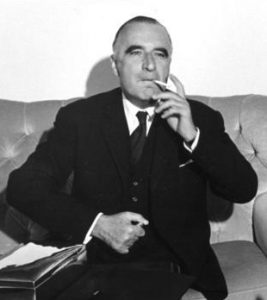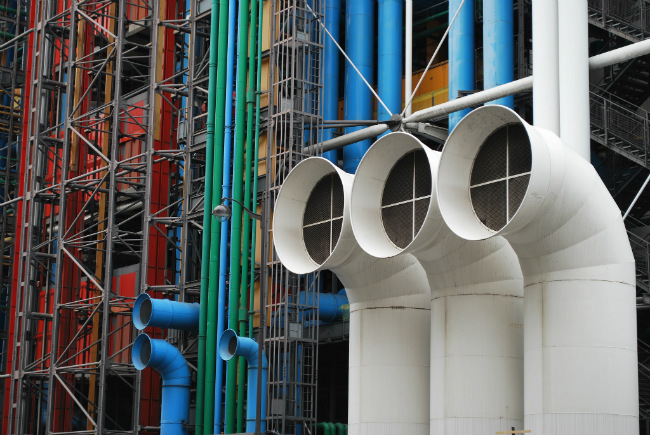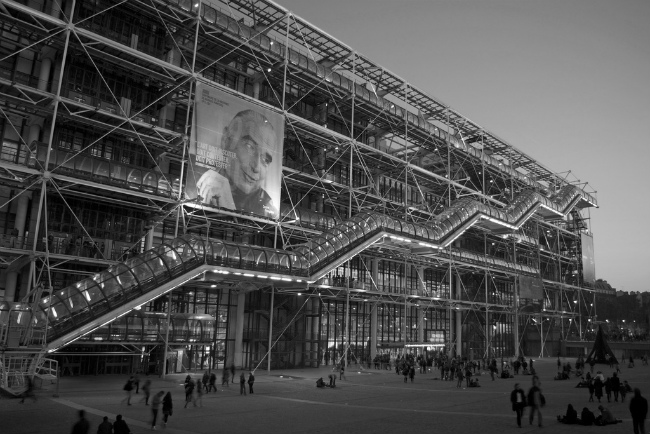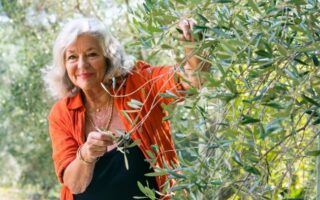Poetry, Passion and President Pompidou: Interview with French Poet Jean-Luc Pouliquen
French Poet Jean-Luc Pouliquen Talks about President Georges Pompidou’s “Passion for Poetry” and the State of Poetry Today – Including his Own
Translated into English by Beth S. Gersh-Nešić
Bonjour Paris marked the 40th anniversary of the Centre Georges Pompidou in January by offering a list of events in 2017 throughout France. Before the festivities end, let us not forget that President George Pompidou loved poetry passionately, according to French poet and literary critic Jean-Luc Pouliquen, who published Georges Pompidou, un président passionné de poésie with a preface by the president’s son Dr. Alain Pompidou (Édition L’Harmattan, 2016). Pouliquen also wrote about book about Pompidou’s love of art in Dali, son mécène et le président (Dalì, his Patron and the President, 2016).
Here in an exclusive interview with Jean-Luc Pouliquen, we learn about President Pompidou’s literary background, the state of poetry in France since President Pompidou published his Anthology of French Poetry (1961), and Pouliquen’s own journey as a poet with examples of his poetry which address the concerns of our time and the Garlaban poets.
Pouliquen is the author of numerous books of poetry and prose, and numerous books on poetry and prose. Born in Toulon, he currently resides in beautiful Hyères. He was the editor of Cahiers de Garlaban from 1987 to 1997 and has been an active member of organizations that bring arts festivals to Southern France. Personally, I am a great fan of his delicious little novel about a chance encounter of a man and woman in Hyères called La Fille de la Lune (2014); his non-fiction literary jewel Robert Louis Stevenson à Hyères, translated into English by Bridget Tilleray (2015); and his intriguing art history investigation Dalì, son mécène et le président (2016), wherein we learn about Salvador Dalì’s Tuna Fishing (La Pêche au Thon : Hommage à Meissonier) painted in 1966-67, which belongs to the Fondation Paul-Ricard, Bandol/Ile de Bandor, located not far from Pouliquen’s hometown.
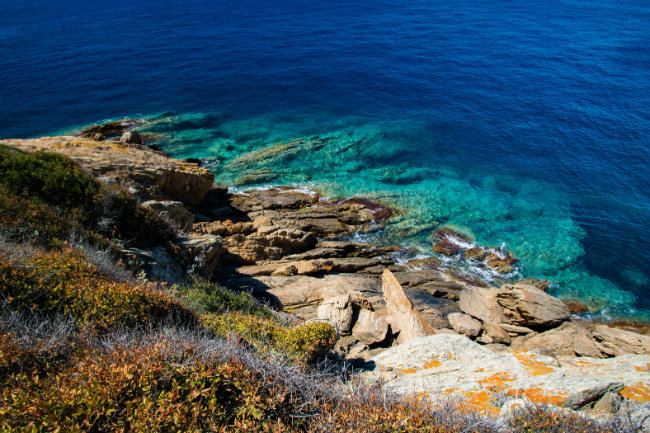
Photo: Office de Tourisme Hyères
Since Jean-Luc Pouliquen’s poetry may not be familiar to you, we thought it might be fun to present two poems in French and English, selected from his collection of poems in Mémoire sans tain, Poetry (1982-2002) (Edition L’Harmattan, 2009). Pouliquen’s blog is L’Oiseau de feu du Garlaban and his poems are also available on Youtube.
* * *
BGN: Bonjour, Jean-Luc, congratulations on being a guest at one of the private festivities to honor the memory of President Georges Pompidou and the 40th anniversary of this spectacular museum. You wrote about President Pompidou’s love of poetry in Georges Pompidou, un président passionné de poésie. When did you decide to write this book and why did you take it upon yourself to pursue this study?
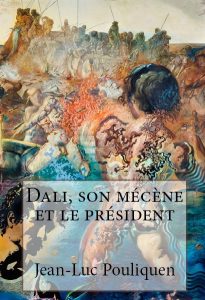
Dalì, son mécène et le président (2016)
JLP: In December 2014 I met Bernard Esambert who was Georges Pompidou’s advisor at the Palais de l’Elysée and today is the president of the Institut Georges Pompidou. I was able to ask him questions that I had been thinking about for quite some time concerning the connection between Georges Pompidou and poetry. His answers enchanted me and encouraged me to pursue my investigation. Georges Pompidou could recite Baudelaire, Apollinaire or Aragon during informal meetings with his staff.
BGN: Can you tell our readers about Pompidou’s taste in poetry? Do you think he was a product of his education or the generation in which he emerged as a young adult?
JLP: Georges Pompidou’s taste in poetry surpassed his classical literary education and developed throughout his entire life. He was the author of an Anthology of French Poetry and had been friends with great poets, such as Léopold Sédar Senghor whom he knew when he was a student in Paris and later on when he had become the president of the Republic of Senegal. His political policies bear the mark of one attuned to human aspirations and profound ideals in the same way that poetry is capable of translating them. For example, he was the leader who created the first Ministry of the Environment in France, followed by a speech delivered to the Alliance Française de Chicago on February 28, 1970, about the potential destruction of nature due to the increasing impact of technology and science.
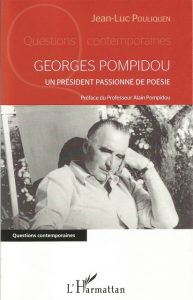
Georges Pompidou, un président passionné de poésie
BGN: Did this concern about nature influence his taste in poetry? Is that evident in his anthology?
JLP: Georges Pompidou was born in a little village in the center of France surrounded by nature. He was not at the time a pantheist. His classical background demonstrated to him that the city could also be a center of influence for the mind. In addition, as President of the Republic, he led a bold political agenda for the industrialization of France. His passion for poetry came first and foremost from listening to the chants of the human soul which rose out of the city or the countryside, across the centuries. His anthology begins with the Ballad of Paris by the poet Eustache Deschamps (1340-1404).
BGN: How does his taste compare to yours? Please tell us about your own education and generation in the history of French poetry. You studied sociology with Michel Crozier and Henri Mendras at l’Institut d’Etudes Politiques de Paris. When did you decide to become a poet?
JLP: George Pompidou followed a curriculum in which the study of Greek and Latin were the cornerstones. He saw the world filtered through this perception of Greco-Roman civilization. This did not prevent him from being open to modernity. The creation of a center of contemporary art in the heart of Paris that bears his name is proof of that. When he was 18 years old, he purchased the collage novel entitled La Femme 100 Têtes composed by the Surrealist artist Max Ernst. My generation felt the effects of the cultural revolution brought about in May 1968, while from Georges Pompidou’s perspective, it was the triumph of the Surrealist André Breton’s ideas. For my generation, the introduction of the humanistic sciences (psychology, psycho-analysis, sociology, etc.) exerted their influence; poets like Jack Kerouac and his Beat Generation friends spread the notion that one questions society. Don’t forget that the French classics in the Anthologie de Georges Pompidou (Charles d’Orléans, Racine, André Chénier, Lamartine, etc,) ends with the Surrealist Paul Éluard. As a sociology student I subscribed to this enormous “May 1968” cultural shift, but choosing to become poet came to me a few years later.
BGN: You have been so active in festivals and other initiatives that promote a love of poetry. Please tell us about your favorite activities these days. Are you still working with children, young adults in the university system, and “life-long” learners in your hometown Hyères?
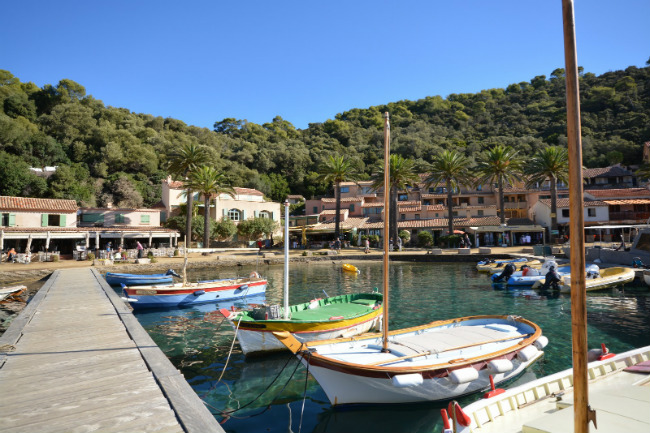
The port of Port-Cros. Photo: Office de Tourisme de Hyères
JLP: My education in sociology made me aware of poetry’s place in contemporary society and the measures one might take to keep it alive forever. I tried to participate in new programs that were invented to reach this goal. Thus I organized encounters between poets and the general public within the framework of festivals completely dedicated to poetry. I went to a lot of schools where I developed a writing program called Les Enfants sont les poètes (Children Are Poets, 2015) aimed at the very young. After that I reached out to public and private high schools and universities in France and abroad. I also made an effort to work more closely with poets and universities in order to make poetry more relevant to their curricula. Right now I lead a writing workshop in Hyères which brings together students, working adults and retired seniors. Once each year we present a public reading of the written texts produced in this workshop.
BGN: You have written about so many luminaries in modern French literature: philosopher Gaston Bachelard; Jean Bouhier, founder of the École de Rochefort; poet Daniel Biga; etc. Do you feel there is a certain artistic personality or poetics that attracts you to their work? Are you looking for a specific style or sentiment? Who, among all these poets, do you feel the closest affinity?
JLP: Gaston Bachelard was a philosopher who was very close to the poets and fed on their works to write his beautiful books about imagination. Jean Bouhier founded the School of Rochefort in 1941 in order to return to poetry its full power and to reaffirm the absolute freedom of the poet in the middle of the war. Daniel Biga knew how to capture and translate the profound renewal of literary and artistic expression that belonged to the 1960s. All three had in common a lyrical form adapted to their period. I did not have the opportunity to meet Gaston Barchelend, whom I had gotten to know indirectly through his daughter Suzanne. His very personal way of placing himself at the intersection of philosophy and poetry is a profoundly human and warm form of writing that never ceases to bring me closer to him.
BGN: Please share your poetry with our audience.
JLP: All right, let’s choose for example these poems:
CHERCHER Searching
Chercher Searching
sur le visage d’un enfant on the face of a child
ou dans les rides de l’âge or in the wrinkles of age
Depuis le temps Since the time
que nous râpons la terre that we scraped the earth
de nos doigts contrefaits with our crabbed fingers
qu’avons-nous exhumé ? what have we unearthed ?
Chercher Searching
au-delà du mensonge beyond the lie
de l’ombre des charniers of the charnel house’s darkness
dans la complainte des peuples in the laments of people
et la musique des feuillages and the music of leaves.
Est-elle si loin Is it so far away
l’aurore fraternelle the dawn of brotherhood
la liberté gagnée Freedom secured
au chaos déferlant ? amid a surge of chaos ?
LES AMIS DE GARLABAN Friends of Garlaban
Un samedi d’octobre One Saturday in October
la semaine pliée the week folded
dans un coin de l’armoire into a corner of the closet
les amis sont venus the friends came
au partage du soir. to share in the evening.
Comme un maître de chai Like the master of a wine cellar
qui a vaincu la grêle who triumphed over the hail
Charles remplit les verres Charles filled the glasses
avec l’alcool de ses poèmes. with the spirits of his poems.
Descendu de Lascours Come down from Lascours
à la suite des arbres following the trees
Pierre fait résonner les voûtes Pierre makes the vaults resound
des cris de la forêt. With the cries of the forest.
Maintenant que la mer s’est tue Now that the sea is silent
Claude reprend son souffle Claude catches his breath
Eric a dévissé pour lui Eric unscrewed for him
deux étoiles dans le ciel. Two stars in the sky.
Entendez-vous cette voix souterraine Do you hear that subterranean voice
que Jean remonte de la nuit ? that Jean brings back from the night ?
Amis Friends
rejoints dans la vallée reunited in the valley
vos mains soulèvent your hands lift
le voile gris des cités the gray veil from the cities
dessous le souffle chaud under the warm breath
de vos cœurs exhalés of your hearts’ exhalation.
BGN: Please tell us about the Cahiers de Garlaban. What was its mission?
JLP: Les Cahiers de Garlaban responded to two movements that were taking place at the same time: a grassroots affirmation in Provence, where it was born, and its reaching out to the general public. The grassroots movement turned into the publication of poets writing in langue d’Oc, the language of the troubadours spoken in the South of France, before French, that carries within itself this primary connection to the original country of its birth. Its openness to the world outside itself materialized through the publication of poets who belonged to several generations, from the old guard in the School of Rochefort to the youngest among the emerging writers. The thread connecting one to each other comes from asking the same questions about humankind and its obligations.
BGN: In view of your poems and the book on President Georges Pompidou’s passion for poetry, do you think he missed his calling? Should he have become a poet instead?
JLP: Georges Pompidou was simultaneously a man with a great literary and artistic sensibility and a man of action. He did not want to be a professor of literature, which he had been originally. He had deep within himself a feeling for fulfilling his destiny and that was political, but in the noblest sense of the word, which included protecting the arts and literature, a civilization’s only influential resources.
BGN: Where is poetry today in France? Is the audience increasing? Are the number of poets increasing? Have you identified a specific kind of “Millennial” poetry emerging today?
JLP: Poetry in France is in a paradoxical situation. Very little is discussed on television or on the radio, but this silence from mainstream mass media hides an intense activity. There are a lot of little publishers, who print poetry on paper, in digital magazines, on websites, and on blogs, which are completely dedicated to it. All over France there are places to meet (festivals, book salons, book signings in bookstores, and readings in cafés, libraries, writing workshops, etc.), which demonstrates that the interest has not declined. However, I wouldn’t say that the audience has increased; it has remained about the same. As for the emerging genres of poetry? More and more young people are turning to performance, the poetry that one sees and hears. The most obvious characteristics of modernity come from the use of new platforms inspired by technology. Alongside them, however, are those who still regard the text as primary and poetry as an interior exercise. Who will be the troubadours of the 21st century? Let’s wait a bit to find out.
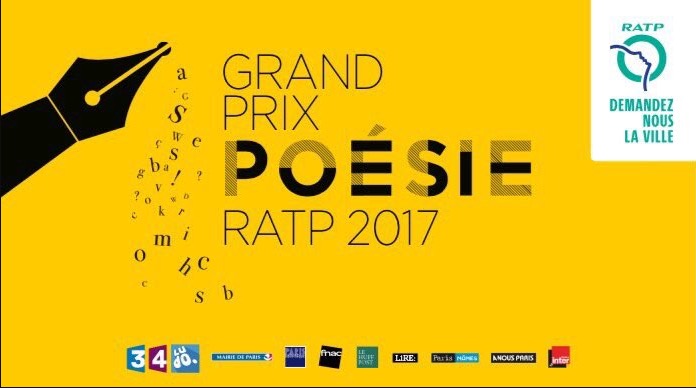
Poetry contest sponsored by RATP, the Paris Metro Authority
BGN: Your book Georges Pompidou, un président passionné de poésie and your book Dalì, son mécène et le président (Dalì, his Patron and the President) both came out last year in 2016. Which book did you write first ?
J.LP: I wrote the book on Georges Pompidou and poetry first, but I wanted also to write something relevant for the 40th anniversary of the creation of the Centre Georges Pompidou. The feeling I experienced in 2012 in the exhibition dedicated to Dalí was the trigger for the second book. I went to the museum to see Tuna Fishing (La Pêche au Thon), the Catalan painter’s masterpiece which was purchased by Paul Ricard, the great industrialist and benefactor in the South of France. Thanks to Georges Pompidou’s creation of the Centre, I was able to see it. I wanted to connect the three men in one book, especially because 2017 marked the fiftieth anniversary of Fishing Tuna and the twentieth anniversary of Paul Ricard’s death. Thanks to the latter’s daughter, I was able to reproduce the painting on the cover of the book.
BGN: In the Dalí book your wrote: “Centre George Pompidou made Paris once more a reference point for the most innovative creativity. It returned, literally and figuratively, contemporary art to the heart of the city. It was a political wish that belonged to the statesman whose name appears on the building today.” Would you like to expand on this observation?
JLP: After WWII, Paris slowly lost its position as the international center of contemporary artistic creativity. There was no museum in the French capital for the great artists from the second half of the twentieth-century. Instead, it was mainly in New York where recognition of the best talents could be found. There had to be some response. At first, André Malraux, the Minister of Culture under Charles de Gaulle, envisioned creating a center dedicated to contemporary art. He enlisted the architect Le Corbusier to draw up a plan. However, he wanted to locate it on the outskirts of Paris and the project was dropped. We had to wait until Georges Pompidou was the President of the Republic in 1969. He had the drive to decisively commit to “the construction of a monumental combination of resources dedicated to contemporary art.” This time the place selected was geographically at the center of Paris, not far from the Hôtel de Ville and Notre Dame, and not too distant from the Louvre and the Opéra.

View from inside the Centre Georges Pompidou. Photo: Bonjour Paris
BGN: Based on your recent experience at Centre Georges Pompidou, do you think President Pompidou would have been pleased with the current exhibitions and programs offered by the museum this fall?
JLP: On 8 November 2017, Professor Alain Pompidou chose the Centre Georges Pompidou to launch the book he just wrote with César Amand entitled Pour l’amour de l’art – Une autre histoire des Pompidou, (For the Love of Art – Another History of the Pompidous) which retraces the exceptional relationship his parents cultivated with the arts. Serge Lasvignes, the current President of Centre Georges Pompidou, wrote the preface. Here is the first indication of an influential interdependence between the family and the institution operating today. Georges Pompidou died in 1974. His wife Claude, with whom he frequented art galleries after WWII and built their collection of contemporary art, forged a close relationship with the Centre until her death in 2007. For her it was a way to continue the work undertaken by her husband. This is what helps us think that the founding principles are still at play, which would have delighted Georges Pompidou. As for the artists currently on view, the former President of the Republic would certainly assess them in his usual way: in terms of the emotional quality they impart to him.
BGN: Thank you so much, Jean-Luc, for sharing your scholarship on Georges Pompidou’s relationship with the arts, your own poetry, and the part you have played in marking this 40th anniversary of the president’s most beloved contribution to France.
Lead photo credit : Jean-Luc Pouliquen and Professor Alain Pompidou during the conference on “Claude and George Pompidou, Art and Culture (1933-1974)” in the Forum of the Casino in Hyères on 4 April 2016. Photographer: Hervé George.


